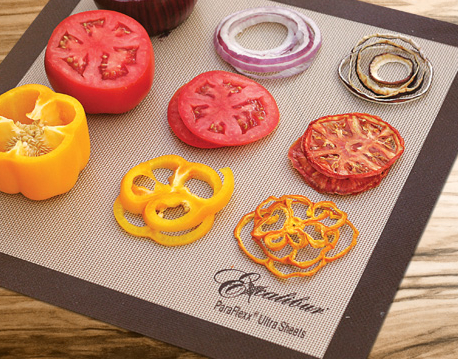The Art of Dehydrating Foods
A couple of years ago, I started dehydrating foods harvested from my thriving urban garden. It takes some work, but the pay-off is definitely worth it. Organic farmer Dan Bodkin, of Gill, MA taught me how to get started. Recently, he reviewed some tips, reveaing his “secret to perfectly dehydrated foods.”

However, before I unlock the mystery for you, you’ll want to understand why it's important in the first place.
When asked why anyone might want to dehydrate fruits, vegetables, and meats, Bodkin explains, “All politics regarding sustainability aside, it’s just plain delicious. Dehydrated foods maintain the majority of their nutrition and color.” Bodkin has been experimenting and perfecting his methods of dehydrating foods for 2 decades. “If you cook, can, or pickle, you will lose some of the nutrition and definitely color. If you have something like a beautiful heirloom tomato, it’s nice to keep the vibrant color,” he points out.
Another reason to dehydrate foods is their value as gifts. “Every year during the holidays, I make up packages of dried fruits and veggies for my friends,” Bodkin tells us. Using a dehydrator, you can also dry or “jerk” meats.
Which Dehydrator to Buy
When you're just getting started dehydrating foods, Bodkin says that your average $50 department store dehydrator is just fine. That's the average price for a basic dehydrator, which is round with five shelving layers and an electric-powered heating unit. If you already have a basic dehydrator, you might want to move on to more expensive models costing upwards of $200. With pricier units, you're paying for faster drying and greater consistency in the final product. (To save money, shop for used dehydrators on eBay or other discount websites.) Bodkin uses what he refers to as the “Cadillac of dehydrators” – the Excalibur.
Getting Started with Dehydrating Food
Bodkin recommends apples, bananas, and pears in terms of foods you might want to experiment with first. “Asian pears, for example, have such a high sugar content, you basically end up with a confection.” He also likes experimenting widely and has dried figs, kiwis, and even watermelon!
Whatever you are looking to dehydrate, select clean, undamaged produce that is not overripe, and meats that are fresh. Experiment with thickness, but basically, you want to cut your product about an eighth inch thick, depending on what you are drying. If you like, add spices to the produce or meats, or in the case of tomatoes, brush them with a light coat of olive oil and herbs. The possibilities are endless. “Some tomatoes come out as rich as a steak," claims Bodkin.
Less expensive models can produce some uneven results. Make sure your product is neither too wet nor too dried. “You don’t want to end up with something you can crack a tooth on, nor do you want a gloppy mess,” cautions Bodkin. With cheaper units, you'll also need to check your dehydrating goodies at least once an hour until you get a feel for how quickly the process is moving. Plan on starting the process early in the day as it can take ten or more hours. The more moisture, the longer your foods will take to dry properly. Apples dry quickly which makes them ideal to experiment with first.
Now ... the Secret
So here’s Bodkin’s secret: take what you have dried off the trays when it is still slightly damp, and store in a rolled up, tightly sealed and stapled paper bag. The magic that happens, Bodkin discloses, is that the items that are a little too moist balance out those that are a little too dry. Bodkin recommends letting the product “cure” for about a week before transferring to storage containers.
Be Sure to Store Correctly
Storage is critical. The one problem you can run into with dehydrated foods is infestation by worms and pantry moths. Bodkin warns even if you have your product stored in a glass jar, if the lid is compromised, he has witnessed moths managing to get in. Glass jars with a good seals are best for storage. Ideally, store jars in the refrigerator or triple-wrap the product in plastic and place in the freezer.
Cris Carl writes for networx.com.
Updated June 11, 2018.
Looking for a Pro? Call us (866) 441-6648

Landscaping Average Costs
Landscapers Experiences

Gas Line Replacement By A Plumber Who Takes Pride In His Work

Grout Replacement Made My Shower Look Brand New



